New Kingdom Egypt Society to the Death of Amenhotep III - Year 12 Ancient
Survey
● The historical and geographical context, including:
– geographical setting, natural features and resources of New Kingdom Egypt and its
neighbours
GEOGRAPHICAL SETTING
Egypt is located in the North-East of the African continent, in what is known as the Near East.
Egypts Neighbours were
Libya - to the west
Palestine - to the north east
Syria - to the north east
Babylonia - to the north east
Naharin (land of the Mitanni) - to the north east
Assyria - to the north east
Anatolia - to the north east
BORDERS
The mediterranean formed Egypt’s northern border, while the Red Sea is the eastern boundary.
The western desert formed a natural barrier between Egypt and Lybia.
The First Cataract at Aswan in the South formed a natural barrier between Egypt and Nubia.
Because of these borders, Egypt was developed in relative isolation from foreign influences, this created a certain degree of xenophobia.
NATURAL FEATURES
NILE RIVER
The most prominent feature of Egypt’s geography is the Nile River, which flows north from its sources in the lakes and mountains of Central Africa. It flows through Egypt to the Nile Delta where it meets the Mediterranean Sea, which Egyptians called ‘the Great Green'. From the ports on the Mediterranean coast, Egypt joined the trading network that supplied valuable raw materials. During the flood season, navigation of the Nile became difficult due to the rapids formed as the river forced its way through the granite outcrops of the First Cataract at Aswan.
NILE VALLEY
The Nile Valley refers to the narrow, cultivated strip of land on either side of the river. The Egyptians called this Kmt, meaning ‘black land’ - black for the silt, the rich fertile soil deposited by the annual inundation or flood.
Beyond the black land lay the desert regions of sand dunes and rocky wastelands. The Egyptians called this desert Dsrt (pronounced ‘deshret), the ‘red land’ - representing all that was barren and hostile.
The Egyptians identified two distinct areas of geopolitical division:
Lower Egypt - northern Egypt, which included the rich lands of the Nile Delta and the Old Kingdom capital of Memphis with its nearby cemeteries of Saqqara and Giza
Upper Egypt - the region south of Memphis to the southern border at Aswan, which included the New Kingdom capital at Thebes, and the royal cemetery known as the Valley of the Kings
RESOURCES
The Nile was important for it’s range of resources and the activities it sustained. These included
irrigation for crop growing
a means of transport
water for drinking, bathing and washing
a source of food - fish, birds and game
animal husbandry
mud for making bricks, a major building material
papyrus, for boats and writing materials
leisure pursuits such as fishing and fowling
Some of Egypts natural resources include
minerals & ores
stone & rock
food resources
rich deposits of gold
natron (for mummification)
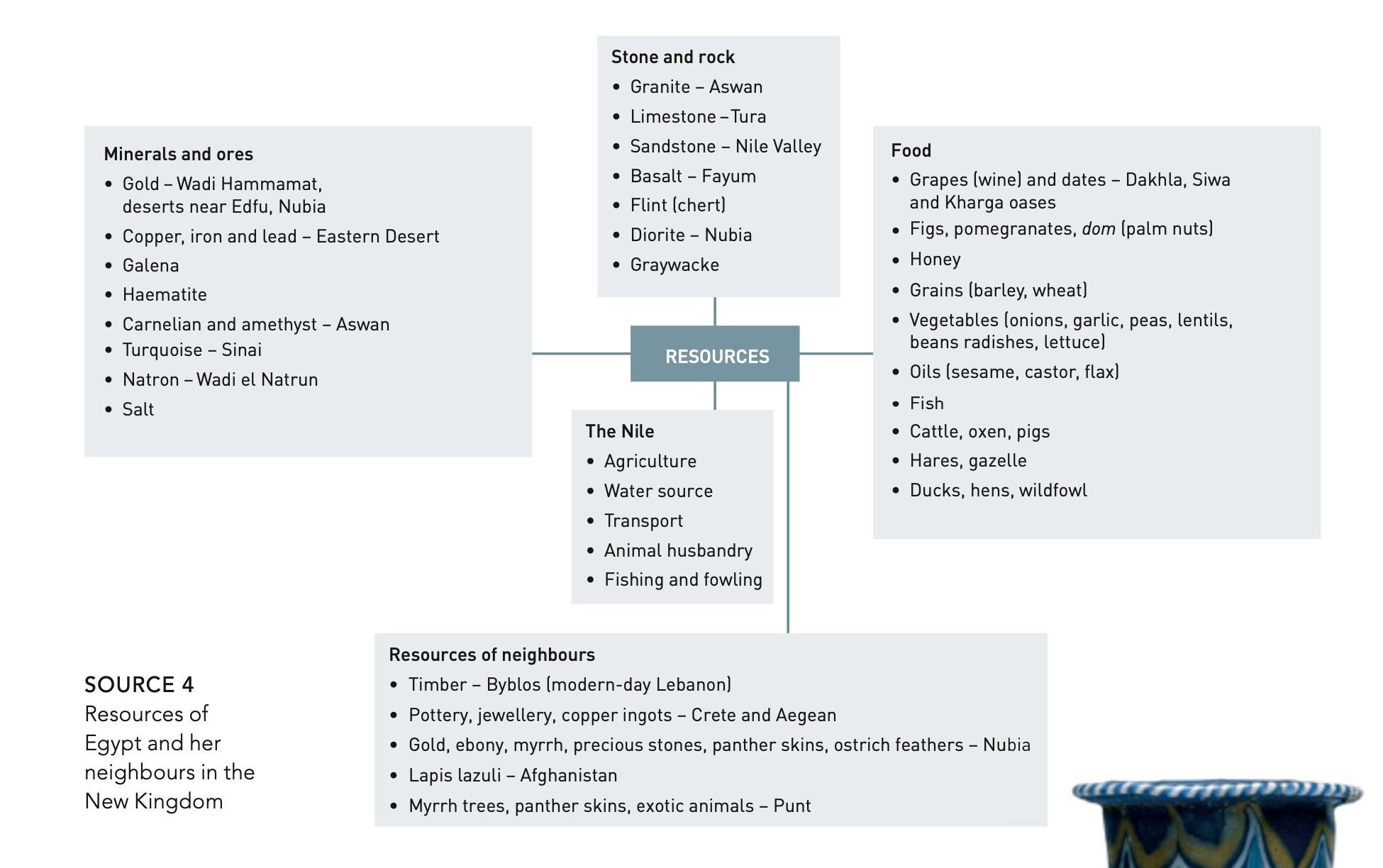
– significant sites:
Thebes
EAST BANK
To ancient Egyptians, the east bank of the Nile, where the sun rose, was for the living. This means that the royal palaces, the temples of the gods and the villages were all located on this bank.
On this side, there were two great temples of Amun, one at Karnak and the other at Luxor.
Karnak was called Ipet-isut, meaning ‘most favoured of places’.
Luxor was called Ipet-resyt, meaning ‘private chambers to the south’
The Luxor temple dates mostly from the reign of Amenhotep III, who wanted to honour Amun with a new temple of his own design.
WEST BANK
To contrast, they believed that the west bank was the place of the setting sun, and was the domain of the dead. The Egyptians called the west bank ‘the beautiful West’
This bank was the site of the pharaohs mortuary temples, built mainly to maintain the cult of the dead pharaoh in his afterlife. The pharaohs’ tombs were not far away from these temples in the valley of the kings. Other members of the royal family were buried in the nearby Valley of the Queens, while members of the Egyptian nobility built their tombs in the hillsides surrounding the valley.
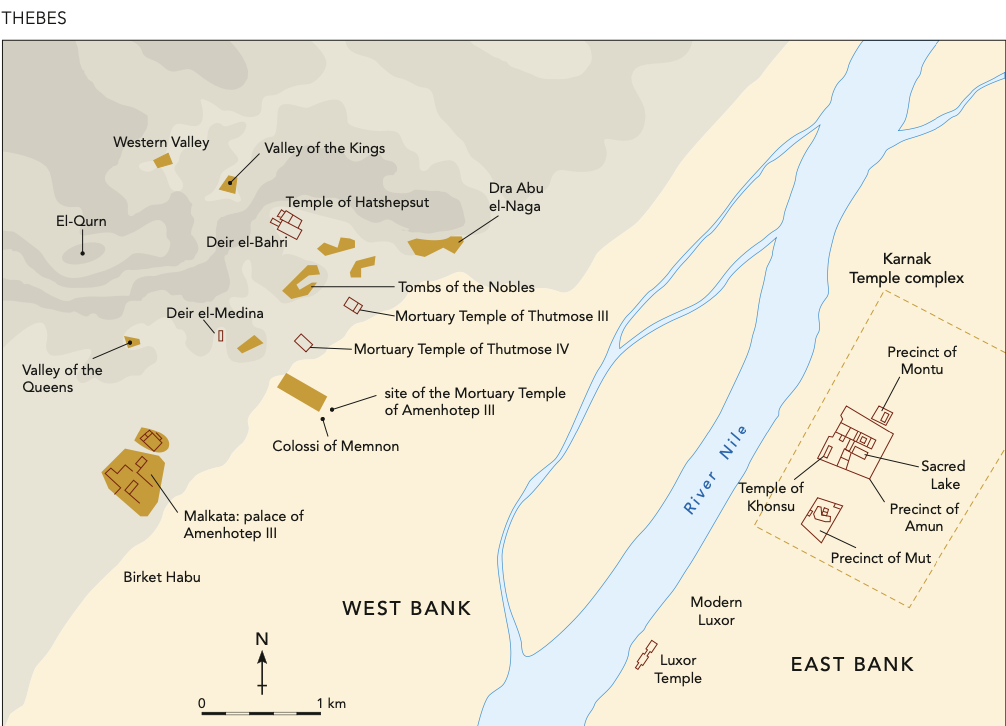
Valley of the Kings
The Valley of the Kings was the New Kingdom royal necropolis. It contained the pharaohs’ rock cut tombs in the limestone cliffs.
Thutmose I is thought to be the first pharaoh to construct a tomb in the valley.
It consisted of two main sections, an eastern and a western valley.
Malkata
Amenhotep III built a huge palace complex on the west bank of Thebes. It covered an area of 30 000 square meters. It’s main purpose was to serve as the setting for the celebration of the king’s hep-sed, his festival of renewal. The modern name of the site el-Malqata means ‘the place where things are picked up’, refering to thee large numbers of faience and pottery found all over the site.
There were many painted rooms, with;
decorated plaster floors
naturalistic scenes of plants & animals
decorative borders of rossettes and running spirals
Excavations of Malkta have revealed the following main areas:
the palace of the king - the private residence of the king
the queen’s apartments
officials apartments
Amun temple
workers village
Birket Habu - an artificial harbour providing access to the Nile

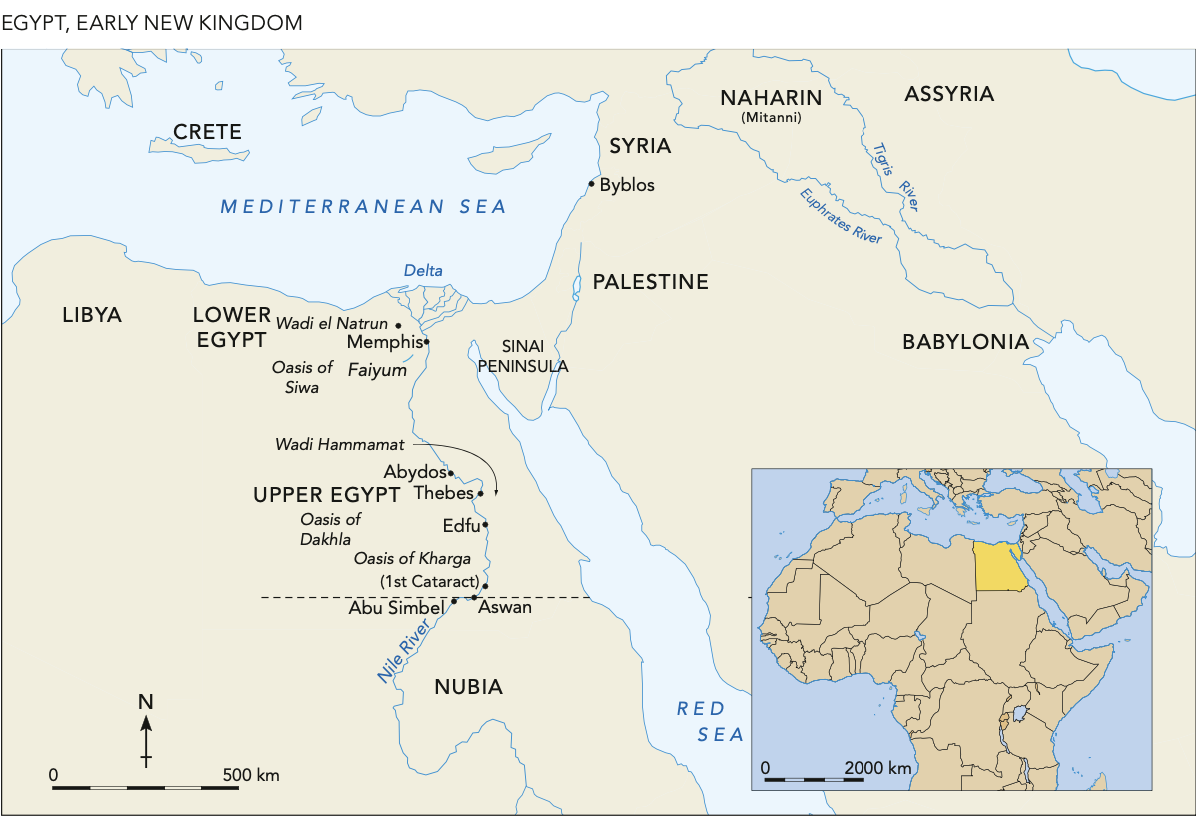
Focus of study
● Social structure and political organisation, including:
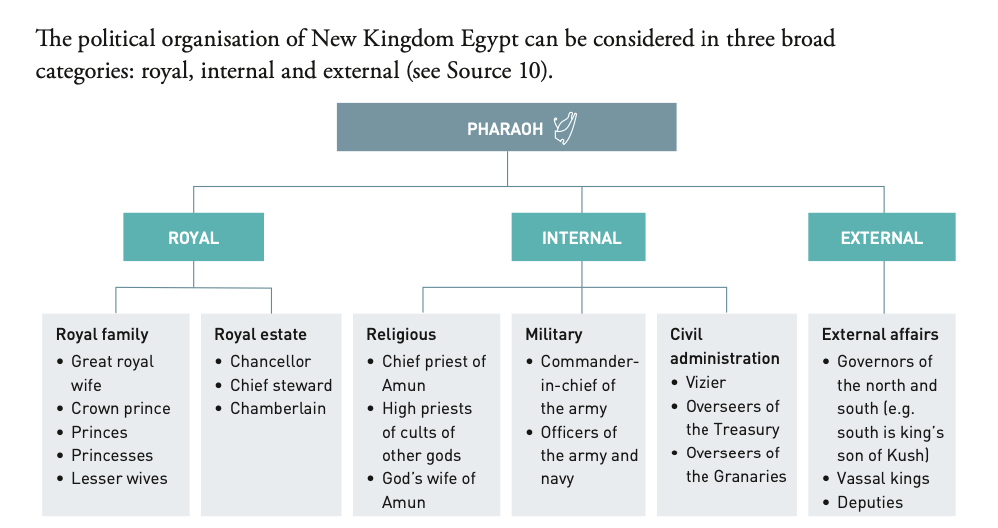
ROYAL
The royal domain included the royal family and the administration of its affairs in the royal estate.
The royal estate was managed by officials including:
the chancellor
the chief steward
the chamberlain
INTERNAL
The internal organisation included religious administration, the military and civil service headed by officials, such as vizers and overseers. All of these officials were directly responsible to the king.
The religious administration was a very important sector of Egyptian government during the New Kingdom. People in this administration included the Chief Priest of Amun, also called the ‘First Prophet of Amun’.
The military administration had a strict hierarchal organisation headed by the pharaoh, who was then advised by a council made up of the vizier and the most senior military officers.
The civil administration was responsible for the internal government of Egypt. The most important officials in the civil administration were the vizers of the north and south. The overseers of important departments such as the treasury and the granaries answered to them. Other civil offices included the judiciary and the police. At local level of district, town and village were provincial governors or nomarchs, town mayors and lesser officials.
EXTERNAL
The external administration handled Egyptian foreign affairs in Syria-Palestine and Nubia. In Syria-Palestine, this was carried out by the governors of the north, who worked alongside local vassal kings of princes. Vassals were left in charge of their own affairs on condition that they took an oath of loyalty to the garrison commanders, in charge of Egyptian troops stationed at key forts.
– roles and images of the pharaoh, the concept of maat
The word pharaoh is the Greek form of the ancient Egyptian term per-aa, which means ‘great house’. It originally referred to the palace of the king, rather than the king himself.
The Egyptian pharaoh exercised absolute power over all of his subjects, and he had both earthly and divine roles. These were to be the provider and protector of his people, who honoured him as king, but also as a representative of the gods. At all times, the pharaohs main role was to uphold ma’at, the order of the universe of which Egypt was a part of.
As supreme authority in Egypt, all matters of Egyptian life were the pharaohs responsibility. He was the chief priest over all religious cults, and he led out in daily offerings to the gods in their temples.
His authority as king was often shown by his regalia or kingly dress. A king could be recognised by any of the following.
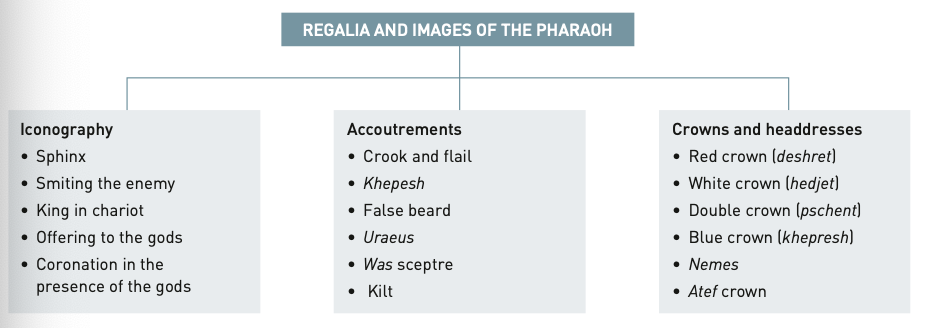
A number of different representations of pharaohs became standard features in pharaonic iconography. They were traditionally displayed as physically perfect specimans regardless of their age of health. As the Egyptian Empire expanded, there was an increase in the ‘warrior pharaoh’ iconography. Such images typically showed the pharaoh attacking his enemies in his war chariot. The other popular image of the time was the pharaoh depicted as a sphinx, either seated or trampling enemies underfoot.
THE CONCEPT OF MAAT
According to the Egyptian creation myth, the world was in a state of continual tension between order and chaos. The primary duty of the pharaoh was to maintain ma’at, the harmony of the universe, and protect Egypt from the forces of chaos. The concept of ma’at also embodied truth and justice.
ma’at was personified as a goddess, usually depicted wearing an ostrich feather on her head. This godess controlled the cycle of the seasons and the stars and, most importantly, the relationships between the Egyptian people and their gods.
During the Eighteenth Dynasty, the pharaoh’s authority was linked to the goddess Ma’at, whose title ‘Daughter of Re’, complemented the pharaonic title ‘Son of Re’.
LINKS TO THE GODS - THE ROYAL TITULARY
The pharaoh had five great names, these were;
Horus - The first name, which identifies the pharaoh as the earthly manifestation of the falcon god, Horus
Nebty - meaning ‘Beloved of the Two Ladies’. The two ladies are Nekhbet, the vulture goddess representing Upper Egypt, and Wadjet, the cobra goddess representing Lower Egypt.
Horus of Gold - Horus is represented by a falcon standing on the hieroglyphic sign for gold. This symbolises the divine and eternal nature of the king.
nswt bity - meaning ‘He of the Sedge and the Bee’, represented by a sedge reed, symbol of Upper Egypt, and a bee, symbol of Lower Egypt. This refers to the kings rule over both Upper and Lower Egypt.
Son of Re - the fifth name emphasised the link between the king and the sun god. This is the personal or family name of the pharaoh.
– roles of the vizier and members of the religious, administrative and military elites
The most important member of the government below the pharaoh was the vizer.
He supervised the work of other officials, acted as the king’s deputy and was responsible for all the main departments of government.
During the New Kingdom, the administration of the state became increasingly complex. For this reason the office of the vizer was split in two: one controlled the north and the other, based in Thebes, controlled the south.

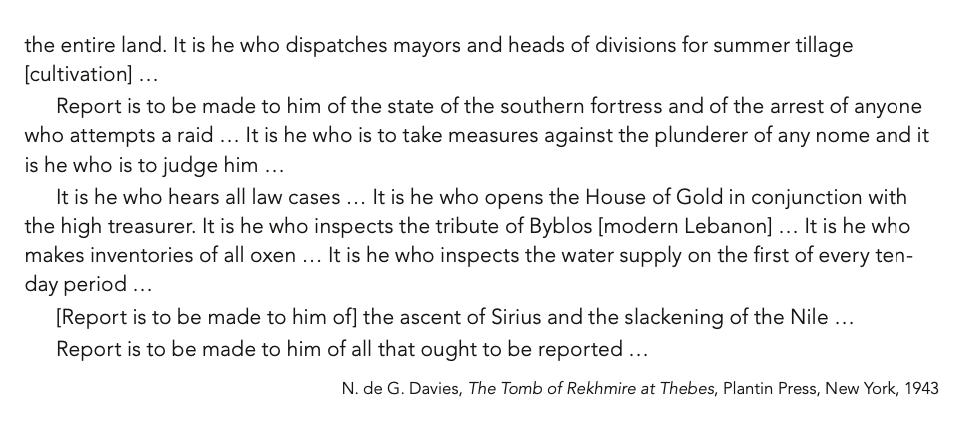
– nature and role of the army
In New Kingdom Egypt, the army was a professional standing force. It served as a focus for the growing nationalism stimulated by victories in the war of liberation over the Hyksos. Later, as Egypt began to develop an empire, the army won further victories over the ‘wretched Kush’ and the ‘miserable Asiatics’, the terms used by the Egyptians to describe their enemies.
COMPOSITION OF THE ARMY
In the early Eighteenth Dynasty, the army consisted of two divisions, each commanded by a general. Infantry contingents comprised of spearmen and archers. There were also chariotry divisions led by the pharaoh himself. An elite infantry corps, known as the ‘braves of the king’, formed the spearhead of infantry attacks.
The army was organised into the following sections;
division - approximately 5000 soldiers
host - approximately 500 soliders
company - 250 soliders
platoon - 50 soliders
squad - 10 soliders
WEAPONRY AND ARMOUR
The Egyptian infantryman was equipped with long-range and short-range weapons. The most important long-range weapon was the bow. For hand-to-hand combat, the solider carried battleaxes, sticks, clubs, flint daggers and khepesh daggers. Protective shields were made of wood covered with animal hide.
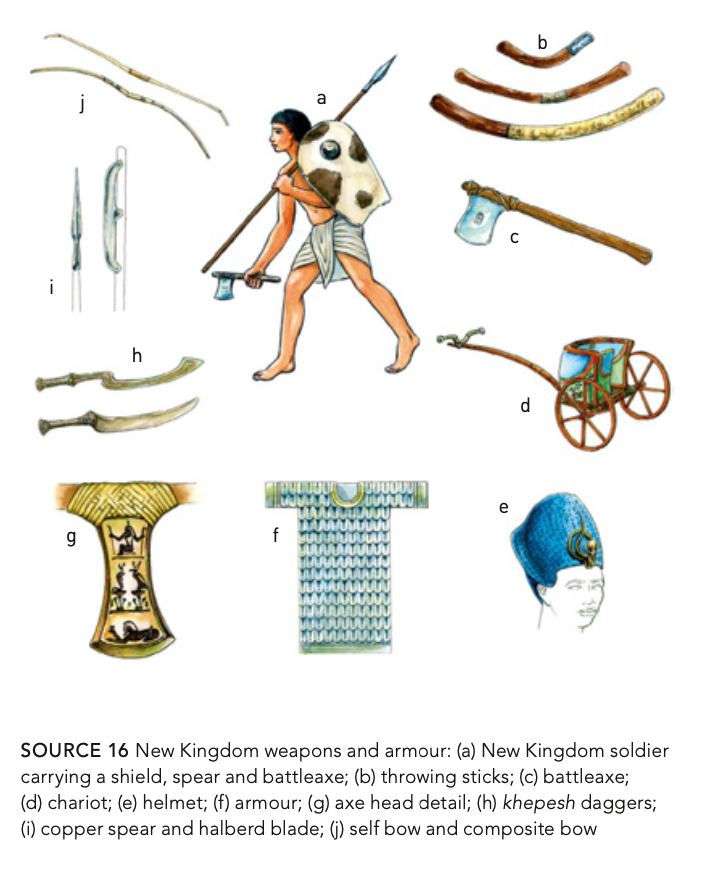
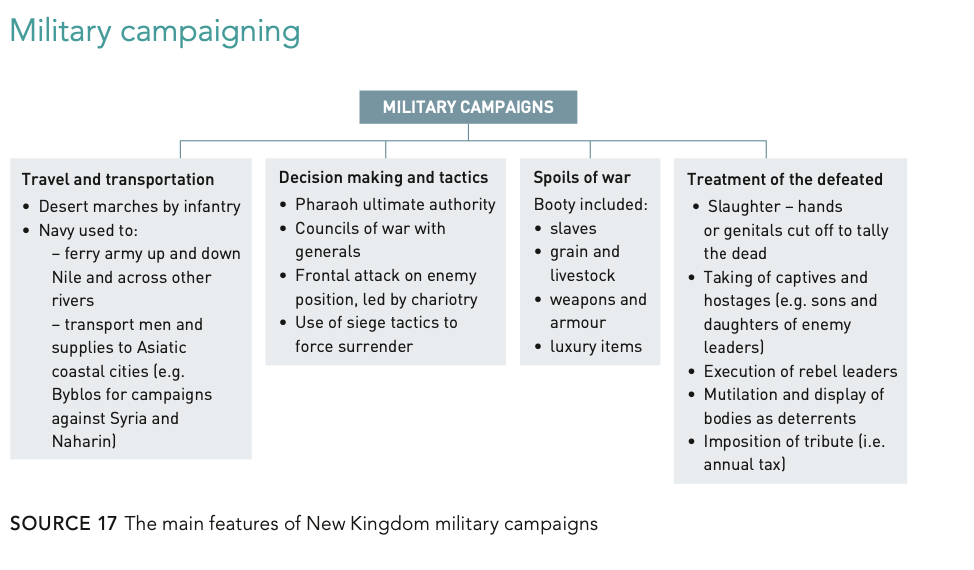
– roles and status of women: royal and non-royal
A woman’s role and status in New Kingdom Egypt depended on that of her husband or close male relative. This was true for both royal and non royal women.
The major sources of evidence for their status are the tombs of their male relatives in which the women play supportive roles in ensuring the afterlife of the tomb owner.
ROLES OF ROYAL WOMEN
Royal women carried out important dynastic, religious and political roles in Egyptian society. Their dynastic role was to maintain the royal family’s line of succession by providing heirs.
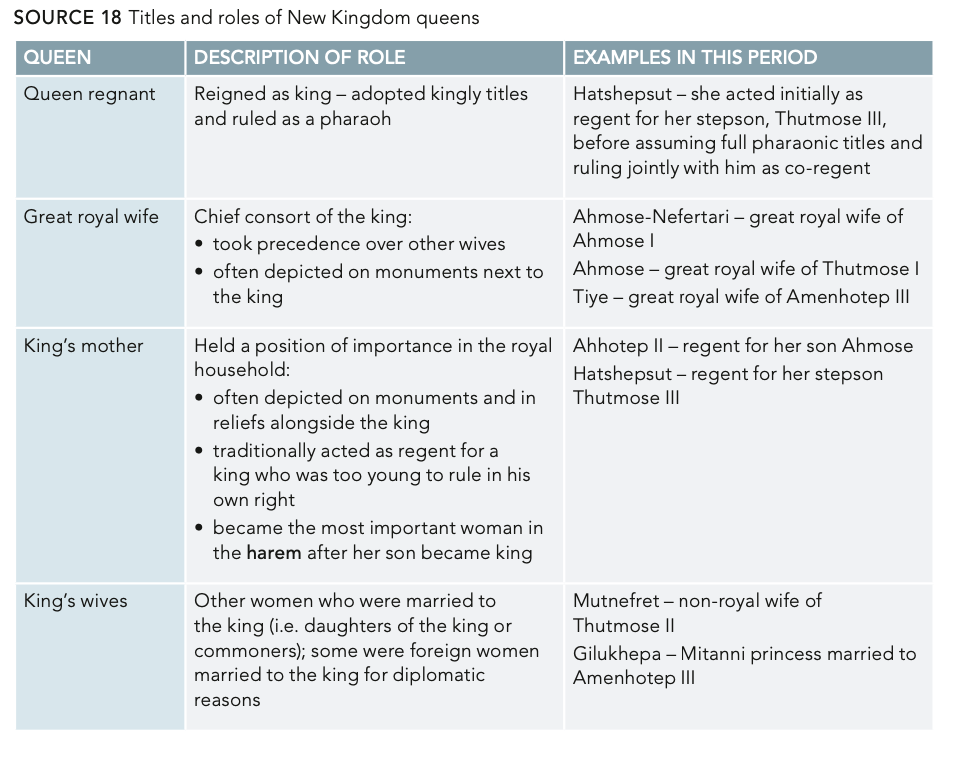
RELIGIOUS ROLE
The religious role of the queen as consort was to provide the female principle that complemented the pharaoh’s relationship to male gods.
The regalia worn by queens demonstrate their links to important female deities. For example, the vulture headdress representing the goddess Nekhbet, the partron deity of Upper Egypt, and was worn by great royal wives.
GODS WIFE OF AMUN
In the early New Kingdom, the title ‘god’s wife of Amun’ was an important title held by female members of the royal family. Holders of this title could claim special lands and perogatives that gave them significant authority in the cult.
Queen Ahmose-Nefertari and Hatshepsut’s role as ‘god’s wife of Amun’ gave them influence within the Amun cult that assisted her elevation to the kingship.
Their duties included enacting important rituals within the Temple of Karnak. Such rituals included offering food to the gods and leading priests in purification rights.
POLITICAL ROLE
The full extent of the political role of queens is unclear. Traditionally, the wife of the dead king acted as regent for the new pharaoh when he was too young to rule in his own right.
LESSER WIVES
Some women of the royal household had the status of queens. Other women, known as concubines, often bore children to the pharaoh and sometimes their sons even became pharaoh.
NON-ROYAL WOMEN
Non-royal women were made up of two main groups - the upper class or nobility and commoners.
UPPER-CLASS
Upper class women were expected to remain home and manage domestic affairs. Reliefs from tombs indicate that these activities included weaving, caring for animals and producing craft items, as well as baking, brewing and cooking.
Servants, nannies & wet nurses were available for women in this class.
Bringing up children occupied a large amount of their time.
Upper class women served in temples, mostly of goddesses such as Hathor, Isis and Sekhmet, as priestesses or musicians. The title ‘Chanteress of Amun’ was well known in the New Kingdom.
Historians are unsure whether these women were literate or not.
MISTRESS OF THE HOUSE
There is very little information on the lives of women of the lower class. They were usually referred to as ‘mistress of the house’.
Daily life scenes in Eighteenth Dynasty tomb paintings sometimes show ordinary women whose function was to help the deceased, usually a male of the upper classes.
Women in this class were most probably occupied with household tasks such as child rearing, preparing food, weaving cloth and a variety of other physical tasks. They also worked in the fields, either on a regular basis, or at least during times of harvest or when extra labour was required.
– scribes, artisans and agricultural workers
Skilled and unskilled workers made up the majority of the Egyptian population. The highest ranking members of this class were the scribes, the literate members of society.
The scribal class included secretaries and clerks who kept records relating to taxation and state administration.
Other skilled artists included artists and craftsmen such as sculptors, carpenters and jewellers.
The mostly highly skilled workers in this classes were employed in pharaohs workshops.
Information about skilled workers comes from the remains of the Deir el-Medina village, which housed the workers who built the tombs in the Valley of the Kings.
The majority of the Egyptian population were unskilled workers, occupied mainly in agriculture - the mainstay of the Egyptian economy.
Agricultural labourers, both male and female, worked on royal and noble estates tilling the soil and producing crops. Other unskilled labourers included animal herders and fishermen, as well as the servants of the nobility.
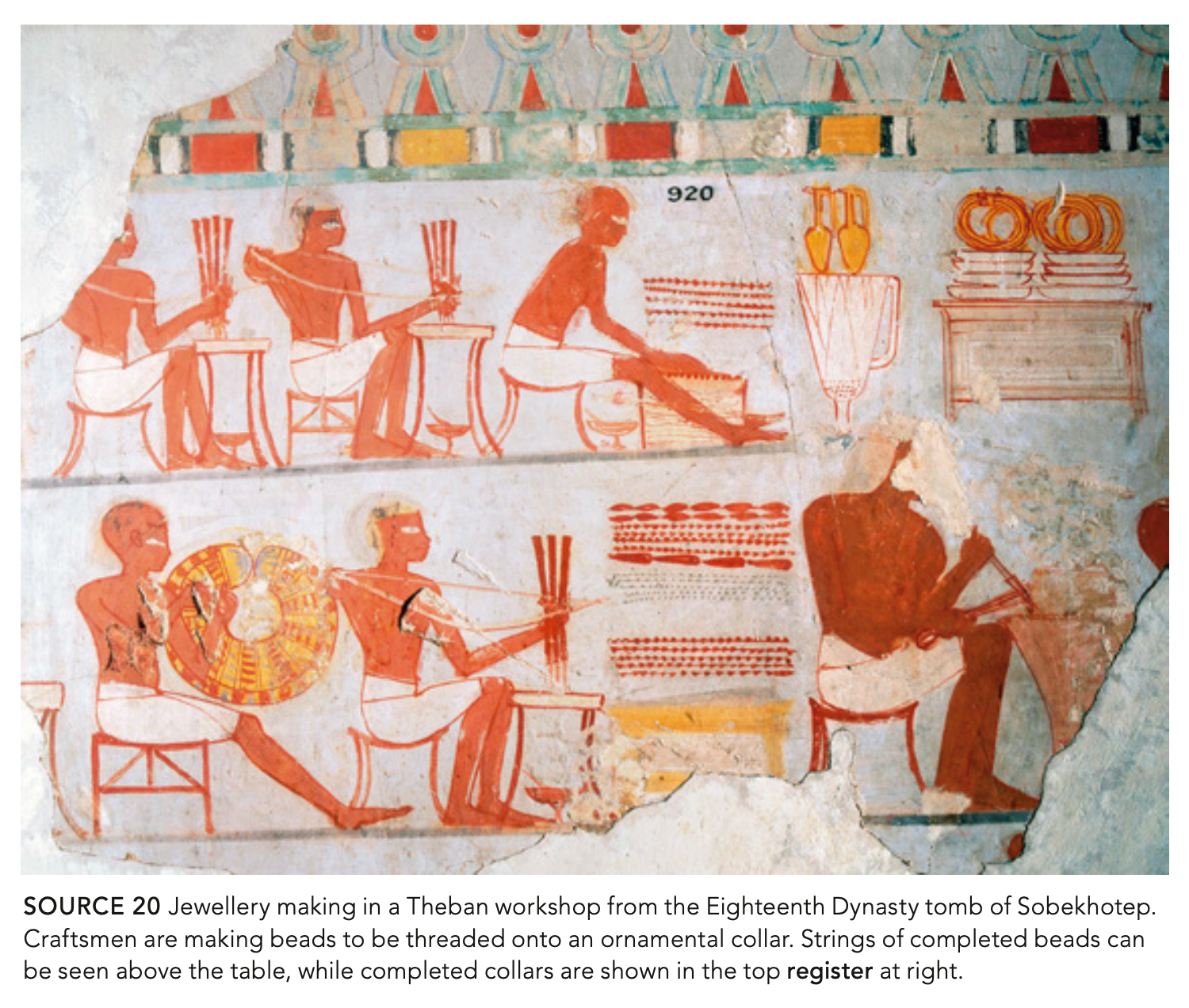
● The economy, including:
– importance of the Nile: agriculture, animal husbandry, transport
The nile was crucial to the development of the economy.
Agriculture depended on the Nile’s annual flood or inundation and food production was always the most important economic activity.
The fertile land that bordered the Nile also supported large hers and flocks of livestock.
The Nile was also the highway and main means of transport of goods between towns and villages.
AGRICULTURE
Egypt was famous for its multiple annual harvests. Herodotus, the greek historian wrote ‘Egypt is the gift of the Nile’.

The main crops were grain, including barley and different kinds of wheat such as emmer, einkorp and spelt, which were used in the production of bread and beer, the staples of the Egyptian diet.
Egyptians also produced a variety of fruit and vegetables, including onions, garlic, lentils, beans, peas, radishes, lettuce, cabbage and cucumbers.
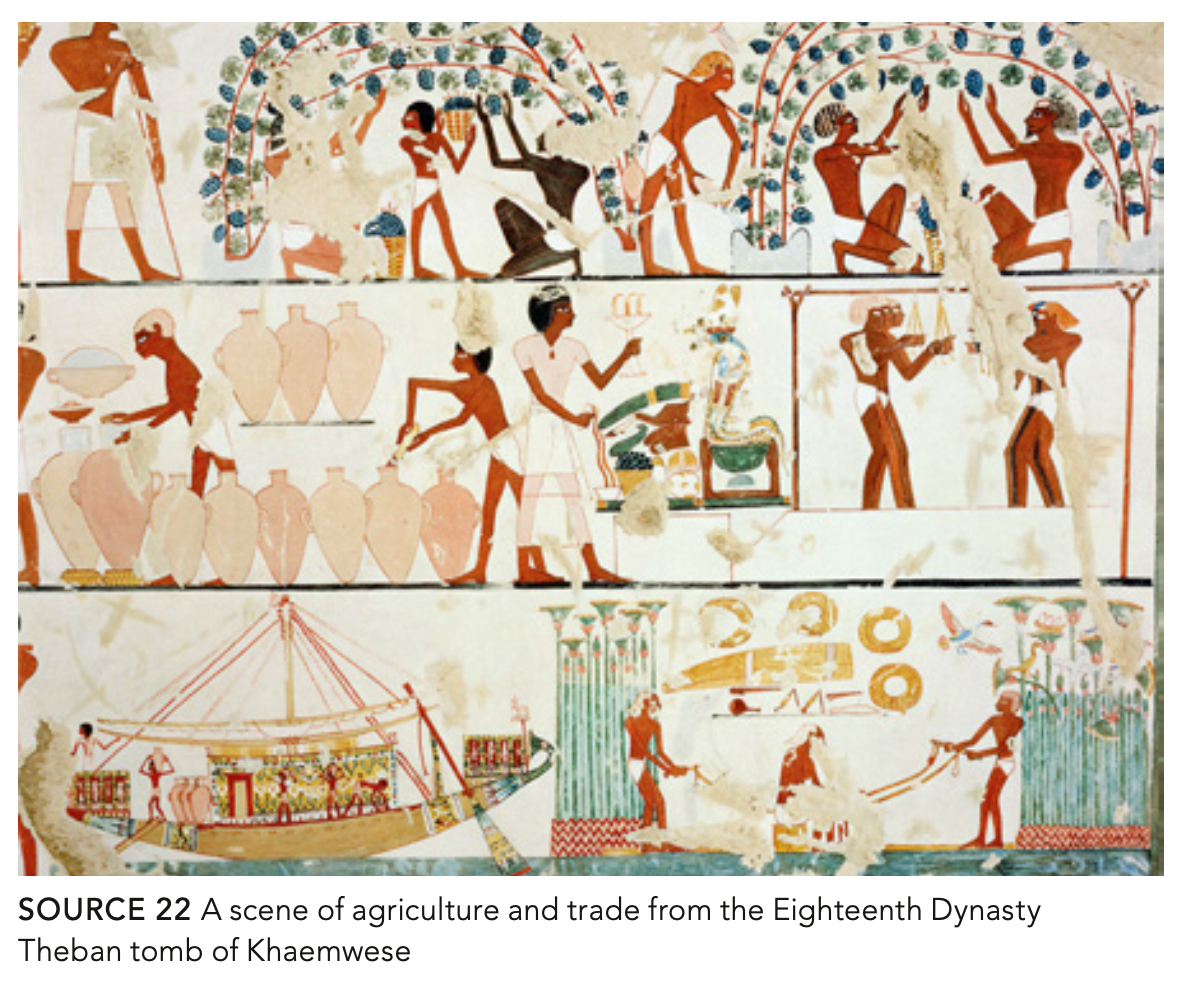
Livestock, an important part of economic life, supplied meat, milk, hides and dung for cooking fuel.
Oxen were used for ploughing and threshing.
Herdsmen and shepherds pastured their animals in the marshes of the Nile. Domesticated animals raised for food included pigs, sheep and goats.
The Nile was the main highway of Ancient Egypt.
Sail boats, like in the lower register of Source 22, plied their trade up and down the river, transporting grain and other local goods.
Ports such as the one in Malkata were busy trade centres.
Markets for small traders were set up at the quays and landing places where trading boats docked.
Official trade was conducted by male traders called shuty.
Nile barges were used to transport heavy building stone, such as blocks of limestone and granite from distant quarries.
– economic exchange: barter and taxation
The main form of economic exchange involved a sophisticated barter system that used a scale of value based on metal weights.
The main standard used for small transactions was copper, and the basic unit was one deben.
Egypts economy depended on the distribution of raw materials and produce, including imported goods and locally produced commodities such as barley, emmer, cattle, wine and linen.
Agricultural and other produce was carefully measured, counted and recorded by scribes.
Government granaries where the grain was stored were essential to the economy. In the absence of a money currency, agricultural yield formed the basis of the taxation system.
Tax collection was conducted by treasury officials accompanied be scribes and policemen carrying sticks. The tax was calculated at the height of the annual inundation.
In addition to agricultural produce, officials assesed trees, ponds, canals, herds, flocks and the yield from hunting and fishing.
Tomb scenes often depict the assessment of produce and collection of taxes by scribes.
– impact of empire: booty, tribute and trade
Egypts economy benefited significantly from empire building.
The conquest of Nubia ensured regular supplies of gold, ebony, semi-precious stones and other goods; while victories in Syria-Palestine opened up sources of timber, raw materials and other luxury items.
The short-term military benefits came in the form of booty, longer term benefits included the tribute and trade that developed in the aftermath of conquest made the most sustained economic contribution.
Egyptian military scribes kept careful inventories of the plundered goods taken back to Egypt after successful campaigns. Pharaohs proudly included lists of such booty on victory stelae and temple pylons to advertise their success.
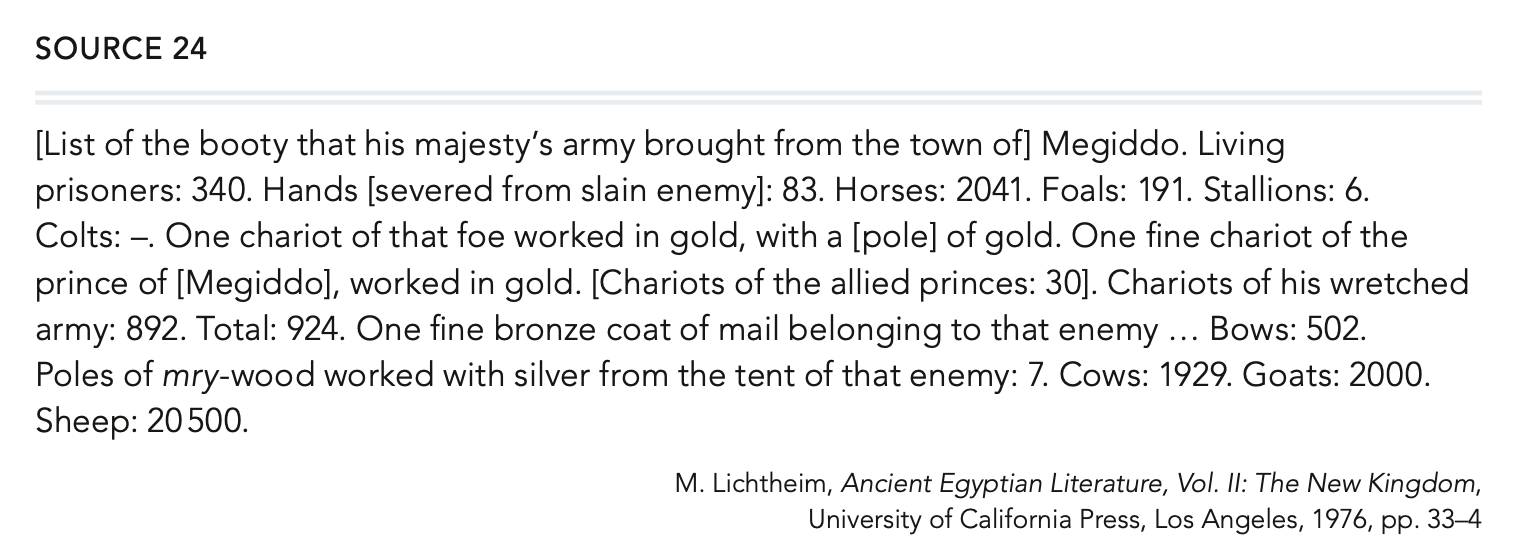
Extract from the annals of Thutmose III records some of the booty taken after thesurrender of Megiddo, the first of more than 17 campaigns into Syria-Palestine conducted by the king over a 20-year period.
– occupations, crafts and industry: wood, stone and metal
The variety of New Kingdom occupations include:
agriculture and domestic
arts and crafts
administration, state, religion
– technology: tools, building materials, techniques and construction
● Religion, death and burial, including:
– gods, goddesses, cults and priesthoods including Amun-Re, Osiris
2.6a Question.
Name | Description | Function | Locality |
Hathor | Cow-headed goddess | Goddess of love, beauty | |
– festivals: Opet, Beautiful Feast of the Valley, Heb-Sed Festival
– myths and legends: Creation myth, Osiris myth
– funerary customs, rituals and texts: afterlife concepts, mummification
– The Book of the Dead and the Amduat (Book of What is in the Netherworld)
– temples – architecture and function: Karnak, Luxor, Deir el-Bahri
– tombs – architecture and decoration: Thebes
● Cultural and everyday life, including:
– art: sculpture, jewellery and wall paintings
– writing and literature – love poetry, Papyrus Lansing: Be a Scribe, Wisdom Literature: the
Instruction of Ani
– leisure activities
– health of New Kingdom Egyptians in this period as revealed by human remains
QUESTIONS
Section 2, question B
Question 10, Option B, A
Identify 2 features of the book of the dead - 2 marks
shows the crops of emmer, barley and flax being harvested
trees laden with fruit
Source 45 - depicts the Judgement of the Dead & the Weighing on the Heart
Outline key characteristics of the valley of the kings in this period - 3 marks
The pharoah’s necropolis of rock cut tombs
There were two main sections - an eastern and a western valley
offered seclusion and protection for the funerary monuments of Amun ‘the hidden one’
What is known about food & clothing in this period - 5 marks
We know that clothing was an important indicator of someones social status in the New Kingdom Egypt. In wealthier families, men and women wore garments with finely woven white linen. Ordinary working men and women wore simpler garments as necessitated by their working lives.
Egyptians had a healthy diet thanks to the variety of the food they could grow in their fertile, nile bank soil. Some diet staples included bread, beer and fish. Egyptians of all classes drank a variety of different types of beers.
What does evidence reveal about social structure in this period (in your answer, refer to source 57, other sources and your own knowledge) - 15
Outline the range of crafts and industry in this period (4 marks)
What do human remains reveal about the health of Egyptians in this period (6 Marks) USE SOURCE
Explain how funerary customs and rituals help us to understand Egyptian Society in this period. Support your response using evidence from Source E and other relevant sources. (15 Marks)
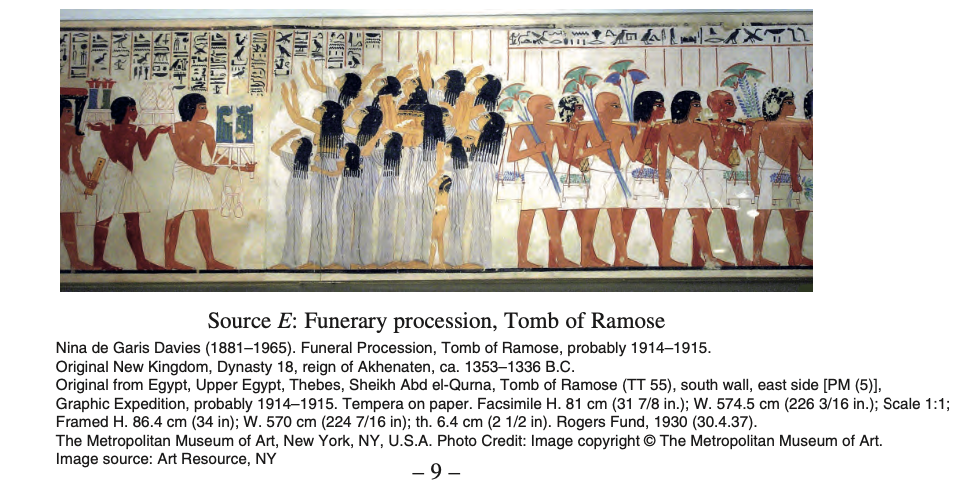
OTHER NOTES (dot points)
Geographical setting, natural features and resources of New Kingdom Egypt and its
neighbours
- Egypt was situated along the river Nile, with Upper Egypt in the south and Lower Egypt in the north. Egypt’s access to the Nile River sustained all life in Egypt.
- The country had been quite secluded from foriegn influence due to its natural borders.
- The country was surrounded by desert to the west and by the red sea to the east. The mediterranean sea and the nile delta were to the north and the cataract at Aswan was to the south, creating a total border around the country.
- In the New Kingdom Egypt trade commenced between the neighbouring countries. Egypt received:
- Timber from Byblos, → Timber was scarce in Egypt.
- Gold, ebony and myrrh from Nubia
- Lapis Lazuli from Afghanistan
Significant sites: Thebes, Valley of the Kings, Malkata.
- Thebes - Was famous in Greek legend and literature as well. It is known as the birthplace of the Greek hero Hercules and played a major role in the stories of Oedipus and Dionysus
- Valley of the Kings - The Valley of the Kings was the burial place of the New Kingdom Pharaohs, as well as some of their relatives, officials and priests. It's tombs are concealed by the cliffs of Western Thebes.
- Malkata - Palace of Amenhotep III
Focus of study
Social structure and political organisation, including:
Roles and images of the pharaoh, the concept of ma’at.
- The pharaoh was viewed as the upholder of ma’at, he was viewed as a god among all men. His job was to oversee the political and spiritual affairs of Egypt.
- SOURCE: Tomb of Rekhmire (vizier to Amenhotep II and Thutmose III) → Quote about the role of the pharaoh to uphold ma’at along with words of praise, showing his high esteem to the public.
Roles of the vizier and members of the religious, administrative and military elites
- Viziers (chief ministers and king’s deputy in ancient Egypt) were the most important officials of civil administration, who were directly responsible to the king and so enjoyed very high status.
- SOURCE: Tombs of viziers (such as tomb of Rekhmire) → Inscriptions outline the roles of the Vizier:
- He hears all legal cases,
- Reports to the king,
- Oversees the army to escort the king
- He oversees the nomarchs and officials
Nature and role of the army
- The core of the Egyptian army was the infantry, which included archers and foot soldiers.
- In the Middle Kingdom, campaigning in Nubia saw the beginnings of a professional fighting force and a distinct military hierarchy. Now in the New Kingdom, with warfare as a constant activity, Egypt required a professional, well-trained army.
- Squad: 10 people, platoon: 50 people, company: 250 people, host: 500 people, division: 5000 people.
- SOURCE: Models of soldiers depicted with weapons in an Egyptian tomb. (Seen right)
Roles and status of women: royal and non-royal
- From inscriptions we learn that there were rich women who were able to own property in their own right and manage their affairs without supervision by a male relative. They could also rule as Queen regent.
- SOURCE → The Mortuary Temple of Queen Hapshetsut.
- A lot of evidence erased by Tutmose III
- Hieroglyphics in Deir el-Bahri
- Non-royal women are not as well documented as they were not rich enough to afford a proper burial. They are divided into two classes: upper class and peasants.
- Upper class women were expected to stay home and manage the household, but they had access to servants and wet nurses to rear their children. Tomb depictions show women weaving and caring for animals as well as baking, brewing and cooking.
- Common women were referred to as Mistress of the house, and usually were preoccupied by household duties and childbearing/raising. Women could also be slaves, as shown by the records of slave trade. Tomb paintings often depict common women working to help the deceased, and as servants to those of the upper class or royalty.
- SOURCE → Wall paintings from tombs in general showing slaves and servants.
-
- Scribes, artisans and agricultural workers
- The scribes were the highest ranking members of the working class. They were very key parts of society as they oversaw all of the taxation, administration and record keeping. The records of events and of the inundation along with agricultural records and taxation documents are all evidence of scribes.
- The artisans were valued and the best were chosen to work in the pharaoh's workshops and help decorate the tombs. These include potters, jewellers, carpenters.
- SOURCE → Deir el-Medina remains of the village including ostraca
- Agricultural workers were the backbone of Egyptian society, they worked during Shemu and peret planting and harvesting, and during the inundation worked as laborers for the temples and major building schemes.
- SOURCE → Tomb of Khaemwese wall paintings show agricultural work.
The economy, including:
- Importance of the Nile: agriculture, animal husbandry, transport
- The Nile sustained all life in egypt by providing:
- Transport → the Egyptians used papyrus boats to transport along the Nile.
- Food → fish, birds, water for crops and game
- Material → mud for brick making
- Irrigation → for crop growing
- Papyrus → boats and writing material
- Animal husbandry → oxen for ploughing fields, animals to provide meat/food and hides and dung for fuel. Animals raised in the wetlands.
- Agriculture was Egypt’s biggest industry with three main periods according to the Nile flood levels.
- Ahket: The Inundation (no field work done.)
- Peret: Springtime (planting crops, rebuilding borders)
- Shemu: the harvest (harvesting crops)
- SOURCE → Tomb paintings, such as the ones in the tomb of Khaemwese
- Economic exchange: barter and taxation
- The main system for barter was a scale of value using metal weights. For small transactions a basic unit of copper called a deben. Things were expressed as a number of deben.
- Scribes documented all of agricultural harvests. The pharaoh would take agricultural products as tax if no money was available. Tax was calculated by the height of the inundation.
- SOURCE → Tomb paintings showing scribes collecting tax and sometimes showing farmers beaten for tax evasion.
- Impact of empire: booty, tribute and trade
- The Egyptians collected tribute from their vassal states. The tribute was a mix of trade, taxes on conquered states and diplomatic gifts, and these were not separated. (referred to as inw)
- SOURCE → Tomb of Rekhmire: tribute scenes.
- Booty was taken from conquered states as they were conquered. This includes living prisoners as slaves, horses, chariots and weapons.
- SOURCE → Annals of Thutmose III
- Occupations, crafts and industry: wood, stone and metal
- Arts and Crafts – artists and painters, sculptors, jewellers, stone vessel makers, potters, glassworkers, carpenters and cabinetmakers, spinners and weavers, smelters, metal beaters and metal founders.
- Royal workshops hired artisans working in wood, stone and metal who produced a variety of goods, including furniture, statuary, vessels and jewellery.
- Finest goods were for decorating tombs and temples, other traded or shipped.
- SOURCE → Deir el-Medina: village for the workers.
- Technology: tools, building materials, techniques and construction
- Ancient egyptians were masters at architectural design and construction engineering
- Ivory Working consisted of figurines, knife handles, wands and spoons
- Stone work consisted of Quarrying, obelisks, vessels and building construction
- SOURCE → Temple of Karnak
Religion, death and burial, including:
- Gods, goddesses, cults and priesthoods including Amun-Re, Osiris
- Osiris: God of the afterlife and resurrection. According to myth, Osiris was deceived by his brother Seth and locked in a casket and thrown into the Nile to float to byblos. Isis finds him but then he is killed by Seth and his body is dismembered and spread across the lands. His sister Nephythys and wife Isis revived him and allowed him to descend down to the underworld to reign as its king. Both king and commoner associated with his name after death.
- SOURCE: Reliefs in tombs
- Amun Re was the creator god and the god of the sun. He was chief god of the Egyptian pantheon and the state god of the religion.
- SOURCE: The temple at Karnak for Amun Re’s worship.
- The priests were ranked according to position and were servants of the gods.
- The high priest was appointed by the pharaoh, only he and the pharaoh could enter the innermost part of the sanctuary. The Second Prophet was in charge of the estate/livestock of the temple. There were also part time priests called wab priests that rotated serving in the temples on a four month cycle.
- The temple was not a place for worship, (no one went in) so the priests did not minister to the people or have heavy religious teachings.
-
- Festivals: Opet, Beautiful Feast of the Valley, Heb-Sed Festival
- The Opet Festival
- Was the major festival of the Theban calendar.
- Revolved around the fertility of Amun-Re and the sexual potency of the pharaoh.
- Began in the second month of the flood season and lasted 4 weeks
- It was mainly a ritual procession and confirmed the kings continued favour with the gods and ensured stability and prosperity of the land for another year
- The Beautiful Feast of the Valley
- Involved an annual procession in which the cult statues of the Theban family were carried across the Nile to visit the mortuary temples of the deceased rulers on the western bank.
- Provided opportunity for families to visit the tombs are their loved ones and carry out various rituals. Families brought food and drink to their deceased relatives so that they could continue to exist in the afterlife.
- Was a time of holiday and celebration
- The Heb-Sed
- Ensured that the pharaoh was still capable of performing his ritual role.
- The pharaoh ‘died’ and was reborn, going through a second coronation. This regenerated the king powers and renewed his relationship with the gods
- Usually held after 30 years of a pharaoh's reign
- Amenhotep III celebrated 3 - in the source below amenhotep III is shown raising the djed pillar (a symbol of stability and strength), he is followed by Queen Tiye, who is followed by 16 princesses shaking musical instruments used in religious rituals.
- SOURCE → Kheruef’s tomb (Amenhotep III’s Official.) showing Amenhotep III’s Heb-sed
- Myths and legends: Creation myth, Osiris myth
- The creation myth states that Amun Re created himself from the waters of nun that covered the whole earth on a mound that emerged from the water. He then created his own children, sneezing out Shu (Air) and spitting out Tefnut (Moisture). Shu and Tefnut then had Nut (Sky) and Geb (Earth) who then parented Osiris, Isis, Nephthys and Seth. they became the Heliopolitan Pantheon.
- SOURCE → papyrus/wall paintings found showing parts of the creation myth.
-
-
Funerary customs, rituals and texts:
- Burials took place on the west of the Nile due to the symbolism of the sun setting in the west. Once on the west bank, an oxen would drag the mummy in a boat shaped bier. A priest would walk in front of the body sprinkling milk and burning incense. Mourners would accompany the mummy, including two female relatives dressed as Isis and Nephthys wailing and attending to the mummy. Following behind was mourners carrying food for the funeral banquet and a sled carrying the canopic jars.
- The Opening of the Mouth ceremony was an incredibly important ceremony as it allowed the deceased to be able to eat in the afterlife, and symbolised the turn over of power. The sem-priest (successor) touched the eyes, ears, and mouth of the mummy at the entrance to the tomb.
- SOURCE → Tomb wall paintings in most tombs.
-
- Mummification
- Mummification came from the belief that the body was needed in the afterlife. It was a key part of Osirian burial. It was a specific process depending on your social status.
- The upper class removed all organs and placed them in canopic jars, then cleaned the body out and filled it with aromatic substances and spices injected frankincense and sewn up. Then they dried the body in natrum for 70 days and wrapped it in linen cloth and smeared it with gum. The body was then placed in a wooden case in the shape of a man.
- Lower than that was the ability to inject the body with cedar oil and clog the opening, leaving it in natrum for a prescribed number of days. Then the hole is unplugged and the liquidized organs are drained out of the body.
- For the lowest classes, simply purge out the body’s insides and lie in natrum for 70 days.
- SOURCE → Herodotus writings
- SOURCE → Bodies/mummies found
-
- Afterlife concepts,
- The Egyptians believed their soul/personage had multiple elements that split during the afterlife. These are:
- Ka → the creative life force. In the afterlife, the ka continued living, but needed access to the body. (this is why mummification was so important). It needed food and drink for sustenance. The ka was restricted to the tomb.
- Ba → the ba was the spiritual life force, but also a part of a person's personality. While the ka was restricted to the tomb alone, the ba could roam during the day and return to the mummy at night.
- Akh → fully resurrected form of the deceased. (Close to a spirit or ghost). Believed to have positive or negative influence beyond the grave on the living world.
-
- The Book of the Dead and the Amduat (Book of What is in the Netherworld)
- There were two books regarding the afterlife. One for the king and one for the commoners.
- The Amduat was the book of the afterlife for the pharaoh. The book contained osirian and solar cult beliefs as the king because Re and Osiris. The king's journey from death to the afterlife paralleled the rising and setting of the sun. The king needed to navigate the duat (underworld) during the night and fight the forces of evil that tried to stop the sun from rising, and would be reincarnated as Re in the form of a scarab beetle in the morning. The osirian belief states that the king would become one with Osiris and included mummification and other osirian elements. These two were contradictory but accepted at the same time.
- The book of the dead was for commoners and stated that their heart would be weighed against a feather by Anubis. The scales would judge the dead. If the test was passed the deceased passed into the fields of reeds (paradise) to help cultivate the paradise.
- SOURCE → “Book of the Dead” Chapter 125 shows heart weighing taking place.
-
- Temples – architecture and function: Karnak, Luxor, Deir el-Bahri
- Mortuary temples were dedicated to a deceased person, while cult temples were to a cult. Mortuary temples were on the west bank with the tombs, while cult temples were on the east bank.
- Mortuary Temples were dedicated to a deceased king and had priests attending to the King’s Ka. They had a similar pattern to the other temples in Luxor and Karnak, except for Hatshepsut’s temple, which introduced dramatic innovations.
- SOURCE → Amenhotep III’s Mortuary Temple and building stela.
- Hatshepsut’s Mortuary Temple in Deir el-Bahri
- The temple in Luxor was built around Middle Kingdom remains by Amenhotep II. It was the focus of the Opet Festival and was dedicated to Amun. it aligned with the temple in Karnak on a north-south axis, allowing the statue of Amun’s precession from his shrine in Karnak to Luxor to work well. It included:
- A colonnade → seven pairs of columns,
- A peristyle court → open courtyard with double rows of columns.
- The great hypostyle hall → 42 bud columns in four groups of eight.
- Antechambers → reliefs of Amenhotep making offerings to Amun
- The birth room → dedicated to Amenhotep II’s birth and presentation to the gods. (believed to be important in the Opet Festival for the renewal of the king’s reign)
- The Barque shrine → containing the baque that carried the statues of the gods from temple to temple in the opet festival.
- Sanctuary → “holy of holies” that contained the statue of Amun
- SOURCE → The temple of Luxor.
- The Temple at Karnak (in Thebes) was a complex of religious buildings covering 100 hectares. It was the major spot for rituals of the cult of Amun. pharaohs would demolish older structures and reuse materials to build new structures to show devotion to Amun. Storehouses housed plundered booty offered to Amun after victories won in his name. The temple contained a large sacred lake and the original temple built by Thutmose I is in the centre. Latter kings added pylons lining the entrance, each larger than the last to create a grand entrance way.
- SOURCE → The temple of Karnak.
-
- Tombs – architecture and decoration: Thebes
- The main cemetery was at thebes on the west bank. The royals were buried in the Valley of the Kings - the royal necropolis, while commoners were buried in the surrounding hillsides.
- Royal tombs were rock cut out of the limestone cliffs. They contained a well shaft to deter robbers and steer away flood waters and a series of passageways that lead down to the burial chamber. The chamber includes pillared halls and side passageways to store burial goods, with a burial chamber with the sarcophagus in the centre. They were painted with Amduat references and depictions of the King with the gods.
- SOURCE → Tomb of Amenhotep II
- Non royal tombs were smaller and shaped like a T. They had an entrance into a vestibule, with a smaller corridor leading into a chapel with a small niche at the end for a statue of the deceased. A shaft descended from inside or outside the chapel to the burial chamber. Wallpaintings showed daily life/occupation and the funeral of the deceased.
- SOURCE → Tomb of Menna (Scribe and Field officer for Thutmose IV and Amunhotep II)
Cultural and everyday life, including:
- Art: sculpture, jewellery and wall paintings
- For statues and sculptures, big was beautiful, (size really does matter aye girls...) and sculptures/statues were functional rather than decorative. Statues were usually placed in temples to house a person’s ka or to receive offerings. There were two main types of statue.
- Stelophorus: a statue where a figure holds a stela or inscribed stone slab.
- SOURCE → statues of Senenmut, tutor of Hatshepsut’s daughter.
- Naophorous: a block statue image of a male figure, usually combined with a shrine.
- Both sexes wore jewellery of different shape and colour. Most common were earrings, bracelets, pectorals, collars, rings and amulets. Amulets were charms and were believed to have magical protecting qualities. Common amulet designs were modelled after hieroglyphic concepts such as an ankh (life), djed pillar (stability), tyet (knot of isis) was sceptre and wadjet eye.
- Wall Painting was designed to serve the tomb owner in the afterlife and was incredibly popular and precise. Some main feature:
- Largest character was the tomb owner and the gods.
- Guidelines used to arrange rows and figures in registers.
- Simplifies shapes with clear outlines used.
-
- Writing and literature – love poetry, Papyrus Lansing: Be a Scribe, Wisdom Literature: the Instruction of Ani
- Love poetry was written on papyrus and ostraca. They usually recounted the times shared and the physical charms. They often have multiple stanzas that alternate between male and female, and are written from the heart in first person.
- SOURCE → Papyrus from the Chester Beatty Collection
- Scribal texts were written by the scribes, the select few that could read and write. The scribal education was for young men to practice writing long passages out by heart. All officials began with a scribal education. Scribal texts often offered advice or kept record of events and administration.
- SOURCE → royal annals, wisdom literature, legit anything written.
- Wisdom Literature was used to teach moral code or values for living a long prosperous life. They emphasised the importance of humility, patience and trust in the gods. The instruction of Ani is the most famous piece of wisdom literature. Ani was a scribe under Queen Ahmose-Nefertari and his instruction is believed to be written in the 18th dynasty.
- SOURCE → The instruction of Ani
-
Leisure activities
- For Kings and Courtiers
- Hunting - tomb paintings depict bird hunts in the marshes
- Hippopotamus hunting was depicted in Theban tombs although the hippo had long disappeared from the area.
- Fishing
- Gymnastics and athletics
- For Ordinary Citizens
- Board games. Senet is the best known of these, it was played on a board of wood, stone, clay, bone or faience or even a grid cut into the ground.
- Gymnastics and athletics
- SOURCE → Eighteenth Dynasty ebony and ivory Senet game board and playing pieces
-
Health of New Kingdom Egyptians in this period as revealed by human remains
- Studies of over 100 mummies from the new kingdom egypt period show evidence of health issues.
- Paleopathologists found:
- Lung tissue samples show traces of pneumonia and tuberculosis.
- Study of other bodily organs shows the prevalence of parasitic diseases such as those caused by tapeworms, thread worms and bilharzia.
- Other diseases include smallpox, poliomyelitis, malaria and spinal tuberculosis.
- Amoeboid cysts (prevalent in rural areas due to unwashed fruit.
- SOURCE → Bodies.
- Osteorchaeologists found: (in Deir el-Medina)
- Inflammation in the bone due to blood borne infection.
- Osteoarthritis in knee and ankle joints (probably due to hard daily climb to work in the Valley of the Kings).
- SOURCE → Bodies found in Deir el-Medina.
- Women often suffered and died during childbirth and infant mortality rates were high.
- Any medical practices we know of come from tombs and wall paintings.
- SOURCE → Ipwy’s tomb in Deir el-Medina (he was a worker)